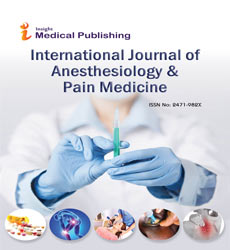A Brief Note on the General Anaesthetics and their Types
Sarah Evans
Sarah Evans*
Department of Anesthesiology, University of Lorraine, Metz, France
- *Corresponding Author:
- Sarah Evans
Department of Anesthesiology,
University of Lorraine,
Metz, France,
E-mail: sarahevans225@gmail.com
Received Date: September 06, 2021; Accepted Date: September 20, 2021; Published Date: September 27, 2021
Citation: Evans S (2021) A Brief Note on the General Anaesthetics and their Types. Int J Anesth Pain Med Vol.7 No.5: 52.
Description
In clinical medicine, general anaesthetics are the only medicines used to achieve unconsciousness as a therapeutic objective. Unlike old hypotheses, all general anaesthetics produce their central nervous system effects through a common mechanism. The study states that general anaesthesia represents several distinct pharmacological effects. It is mediated by different neural circuits and possibly via different molecular targets. This study states that the current molecular pharmacological and transgenic animal investigations. The studies show that various classes of general anaesthetics, which may be distinguished based on clinical characteristics, cause unconsciousness through different molecular targets and, as a result, through different mechanisms.
Various Forms of General Anaesthetics
Various forms of general anaesthetics are thought to selectively interrupt separate critical steps (perhaps in different neural circuits) in the processing of sensory information and memory that leads to consciousness.
Group 1: Etomidate, propofol, and barbiturates
GABA-A receptors are neurotransmitter-gated chloride channels that belong to the same family as nicotinic acetylcholine receptors, glycine receptors, and serotonin type 3 receptors. GABA-A receptors are on both postsynaptic neurons (that receive the neurotransmitter after it has crossed the synapse and may experience an action potential if the neurotransmitter is strong enough) and extra synaptic neurons (an important short distance form of volume transmission) and when they are activated, they decrease neuronal excitation. Eighteen distinct GABAA receptor subunits have been identified using genetic techniques. Group 1 anaesthetics reduce neuronal excitability by increasing GABA-mediated channel activation and prolonging post-synaptic inhibitory currents (IPSCs).
Group 2: Xenon, cyclopropane, nitrous oxide and ketamine
Group 2 anaesthetics also block neuronal nicotinic acetylcholine receptors, which control neurotransmitter release synoptically. These receptors have been shown to have stereo specificity for ketamine. LORR is not connected to neuronal nicotinic receptors, but they may be a key mediator of anesthetic-induced amnesia. Members of the two-pore (2P) domain potassium channel family are influenced by Group 2 general anaesthetics. TREK-1 is a K+ channel that controls the resting membrane potential of neurons and is sensitive to anaesthetics. Volatile anaesthetics also stimulate TREK-1 channels, and TREK-1 knockout mice have been developed. TREK-1 knockout decreases susceptibility to LORR produced by volatile anaesthetics.
Group 3: Halogenated volatile anaesthetics
The halogenated ethers and alkanes of Group 3 general anaesthetics lack substantial selectivity for general anaesthetic target molecules. GABA-A receptors and closely related inhibitory glycine receptors are selectively modulated by Group 3 drugs, which also activate 2P potassium channels and block a variety of excitatory cation channels. Group 3 drugs may also operate on pre-synaptic sites.
Inhibitory GABA-A and glycine receptors are enhanced by volatile general anaesthetics. GABA-A receptors have been investigated and amino acid residues in the transmembrane domains of both and subunits have been found to be determining anaesthetic sensitivity. Transgenic mice lacking the GABAA receptor three subunits had no alteration in their LORR need for volatile anaesthetics.
Anesthetic targets and drug-induced consciousness models
Consciousness is a complex mechanism that analyses and processes new primary data as well as memories into highfidelity subjective creations (qualia).
Conclusion
The concept that general anaesthetics impair basic sensation has limited evidence (detection, reception). Group 2 drugs like ketamine and nitrous oxide appear to work by obstructing signal filtering, perhaps changing the quantities or intensities of sensory inputs, or enabling unconscious impulses to seep into conscious processing. Nitrous oxide and ketamine, on the other hand, sustain or increase cortical activity, implying enhanced, perhaps overloaded neuronal activity. Ketamine and nitrous oxide have only little impact on key "unconscious" processes like respiration and blood pressure control, indicating that their activities are relatively selective for filtering functions, which are most likely found in subcortical circuits.
Open Access Journals
- Aquaculture & Veterinary Science
- Chemistry & Chemical Sciences
- Clinical Sciences
- Engineering
- General Science
- Genetics & Molecular Biology
- Health Care & Nursing
- Immunology & Microbiology
- Materials Science
- Mathematics & Physics
- Medical Sciences
- Neurology & Psychiatry
- Oncology & Cancer Science
- Pharmaceutical Sciences
